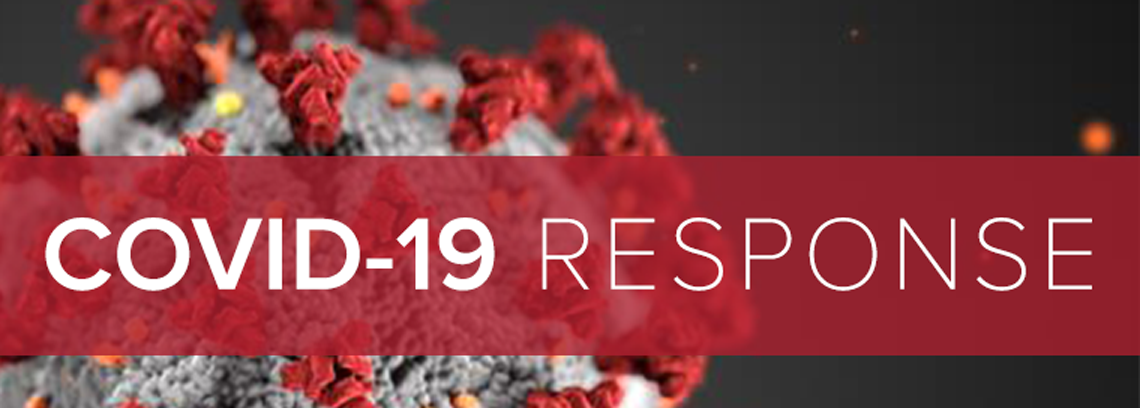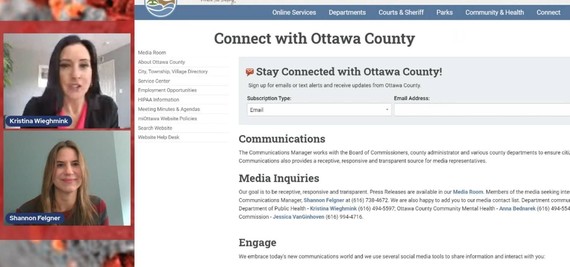March 26, 2021
Good Afternoon!
Today’s Digest features more information about COVID-19 vaccinations and other important updates.
The County embarked upon the Four C's Organizational Improvement Initiative back in 2012-2013. We have achieved many goals in Customer Service, Cultural Intelligence, Communication and Creativity along the way. In today’s Digest edition, Shannon McGoran, Innovation Specialist in the County Administrator’s Office will provide an update on the Creativity “C”. The Creativity initiative focuses on both what are traditionally considered to be “left” and “right” spheres of the brain. LEAN being the high order of left brain thinking and innovation being representative of right brain thinking. Shannon and various teams have made major advances in how we approach continuous improvement in the Ottawa County organization, and I think you will enjoy her update.
Al Vanderberg | County Administrator
 118,983 vaccine doses have been administered to Ottawa County residents, as of March 25, 2021. Over 33% of all Ottawa County residents have received at least one vaccine dose (this includes first dose for persons 16 years of age and older), and over 53% of residents that are 65 years of age and older have completed their vaccination series.
 View Public Information Officer Kristina Wieghmink's March 17 interview here where she discusses outreach to the community with Communications Manager Shannon Felgner.
-by Shannon McGoran
Did you know, on average, kids ask 40,000 questions between the ages of 2 and 5? According to Warren Berger, author of A more beautiful question: the power of inquiry to spark breakthrough ideas, schools and workplaces haven’t provided the time or patience for the questions. Kata and design thinking encourage ideas and experimentation.
 As we take on a new mindset and learn a new skill, daily, frequent practice is needed to make it habit. We are building new neurological structures which, when strengthened through practice, become our go-to for addressing problems (Mike Rother). It’s important to practice scientific thinking (the underpinning of Kata) through experimentation, incremental learning and coaching. We are all hard wired to be skeptical about change, as it can threaten our survival. Some of our ancestors were slow to adopt the bow and arrow over a spear when killing wooly mammoths. Early adopters ignored their prior experience and gave the bow and arrow a try.
 We are inviting you to join us and become an early adopter in our journey to new ways of problem solving, innovation and creativity.
What steps can you take now?
- Participate in our online Continuous Improvement – The Toyota Kata Method Training where you will gain fundamental kata knowledge and learn how to get started on making small improvements with a 4-step Improvement Kata template. It is published in Topyx. Click on the Catalog link, then Online Learning and search for “Kata”.
- Participate in our Creativity Training session offered virtually on Wednesday, April 29th at 2:30pm or in person on June 29th at 2:00pm. This session introduces design thinking, kata, the online Creativity Playbook and includes the Six Thinking Hats tool to address challenges.
What’s next?
- Watch for an open house invitation to celebrate the recently completed innovation room/design center once MIOSHA restrictions have been lifted and more employees return to their workspaces. This space is a new, fun environment that will be used by design thinking and kata teams.
- Applying Kata: Level 2 Training is currently being developed to help departmental teams apply kata as another problem solving tool in your innovation toolbox.
- Join the Kata DOJO skill development Training sessions to enhance your kata skills after attending the Applying Kata: Level 2 Training.
-
Become part of a kata cross departmental 2nd coaching team to further expand your coaching knowledge and experience with other internal coaches.
Selected Success Stories
Kata
IT chose to use kata to improve and standardize their project management system. After many iterations and experiments, the team provided evidence-based data to users regarding project status and where projects fit within the collective group of projects assigned to County IT.
Fiscal Services used kata to revamp the countywide travel policy, streamline their benefits accounting process, create a best practices implementation plan for file management and storage, and to recreate an audit timeline saving time in the audit completion process. They learned that having metrics is key to making improvements, and that designing and implementing changes in a test environment first allowed the team to go live with zero error!
Public Health applied kata methodologies to the challenge of combining Family Planning and STD functions, thereby increasing the number of patients seen per day. The environmental health team improved their reimbursement voucher process time. The most impactful lesson learned was the value that each team member brings to the process of learning and discovery.
CMH used kata during the grant application process to qualify as a Certified Community Health Care provider and to work with the Local Regional Entity (LRE) to determine disparity and gaps in services. CMH Access Center used kata to reduce screening, walk-in and incoming calls response times. They used kata to complete comprehensive assessments within 14 days of the request and were viewed by the LRE as pioneers of improving this disjointed process.
The Treasurer’s office used the Kaizen process to start improving the tax collection process. Their biggest learning was their ideas discovered through the kaizen process were not optimal when applied. The process has been revised through experimenting with new ideas.
Design Thinking
Parks and Recreation were able to use design thinking to brainstorm ideas around how to increase park usage and desirability to the underserved populations. One of the indirect benefits achieved through this process was a collaborative effort between the County and the Hispanic Center of West Michigan to better serve this population.
Public Health used design thinking to improve the customer experience by streamlining the phone tree process, and to re-evaluate solutions to lead-related problems including forming a lead case management team. They also collaborated with Parks and Rec, GIS and the Performance and Improvement departments to increase physical activity and parks exploration in the Step It Up Walking Challenge Program.
CMH also utilized design thinking to improve consumer self-care through use of technology. Tablets were delivered to consumers containing apps that track sleep patterns, activities, health care, automatic thoughts and exercise.
I have not talked to anyone yet who isn’t very frustrated with COVID-19 and wishes very much that this was all over. Unfortunately, it is not over. Predictions have been pretty consistent that everyone who wants a vaccine will have the opportunity by June and that herd immunity should be accomplished by that time which will hopefully signal life returning to normal or at least a new normal. This is contingent on the new vaccine standing up to the various variants, if they do spread. Another factor will be whether 70% of the population gets vaccinated. So, wanting this to be over and not being willing to be vaccinated may be thoughts that don’t work well together to end this pandemic.
It has become obvious that many people don’t understand the authority and role of county and local government in relation to State government. When people are angry and frustrated with actions of the state of national governments, it is easier to contact local government officials to vent their frustrations. In the current populist movement, there are many frustrated people who interpret the Constitution to mean whatever they don't like as being unconstitutional. People want their local elected officials to stand up for them and don’t understand that the system of government doesn’t work as easy as that. A few thoughts follow in this regard:
- County commissioners, elected officials, judges, county administrators, etc. take an oath of office when they begin their duties in which they swear to uphold the Constitution and laws of the United States and same for the State of Michigan.
- The rule of law is the first and most basic underpinning of the US Constitution and our democratic system of government. The U.S. Constitution sits above all other laws in our system and is followed by laws enacted by Congress. Next in line are the state constitutions and after that come laws enacted by state legislatures. Last in line are the laws (called “ordinances”) of counties, cities, villages and townships; all of whom are creatures of the state and can only perform activities that they are allowed to undertake either by the state constitution or by state statute.
- The system of checks and balances really does work. This was highlighted when the Governor was sued over use of her power under two different emergency powers laws. The Michigan Supreme Court found that Governor Whitmer did indeed exceed her authority under those laws. She then began issuing pandemic emergency orders through the MDDHS Director under the Michigan Public Health Code (which many of us thought made more sense since the beginning of the pandemic). The lawsuit decided by the Michigan Supreme Court did not deal with the Michigan Public Health Code. Thus the orders are legal and with Constitutional law at this time.
- When we apply the rule of law to COVID-19, the pertinent facts are that the Michigan Public Health Code of 1978 was legally adopted by the Michigan Legislature and Governor per the Michigan Constitution as amended. Michigan public health laws have been in place for more than a hundred years. The Michigan Public Health Code provides the Michigan Department of Health and Human Services Director (MDHHS) certain powers during a pandemic to allow for arresting the spread of the disease. One of the major roles of county government in Michigan is to be the boots on the ground implementer of State law at the county level. State law “mandates” certain activities such as the Jail, Community Mental Health, Court system, Prosecutor’s Office, etc. and the County has no choice but to carry those out. Public Health is one of those mandated areas and the Local Public Health Officer, in this case Lisa Stefanovsky, is mandated to follow the Michigan Public Health Code and directives of the State MDHHS Director. Neither I, as County Administrator, nor the County Board of Commissioners has the legal authority to interfere with the Public Health Officer carrying out her duties when she is implementing the Public Health Code. The County is required by law to hire a qualified person to serve as Health Officer and then to equip them (budget, space, technology, etc.) to do their job. In other areas of Health Department work, not related to the Health Officer’s duties under the Public Health Code, the County Administrator has oversight of the Public Health Officer, and I work directly for the full Board of Commissioners.
- It is important to reiterate that if a resident or business calls in a complaint the Health Department will respond to that complaint as they are required to by law. If the situation, once reviewed, is one where the law is being broken, then the Health Department has no choice but to enforce the law. If the County Administrator or Board of Commissioners interfered with the work of the Public Health Officer in enforcing the Public Health Code, we would be violating the law. The State could then determine that we can no longer operate the Public Health Department and MDHHS could come in and take it over.
Against the above backdrop, I would like to discuss a couple of the themes of public comments received at the Board of Commissioners meeting earlier this week under the Public Comment portion of the agenda. Comments were made that the Public Health Department is not exercising the discretion that it has to reduce contact tracing and quarantining of students in schools. Contact tracing occurs when the Health Department is notified that a student has been exposed, or came within 6 feet of someone that has symptoms or tests positive for COVID. The Health Department is required by the MDHHS, per the Michigan Public Health Code, to interview all who have come in contact with the infected individual over a certain timeframe. Those who are located and have indeed been exposed must quarantine for 10 days which is down from the original 14 days. The CDC continues to recommend 14 days but recently added options for a reduced quarantine time from 14 to 10 days, or 7 days with a negative test on day 5 or later. The citizens commenting Tuesday seemed to think that the Health Department has the option to choose between the CDC standard of 7 days and the MDHHS standard of 10 days. This is not the case. The MDHHS has authority over the Health Department which must follow the dictates of MDHHS.
The other main point, brought up in public comment Tuesday and brought up repeatedly by members of the public, is that the MDHHS pandemic orders allow the Ottawa County Public Health Department discretion on whether to enforce the MDDHS orders. Comments Tuesday were part of a string of repeated suggestions by members of the public that the DHHS order said this. The Michigan Public Health Code: Under MCL 333.2235(1), states that "local health departments are authorized to carry out and enforce the terms of this order". This portion of the law confers authority in the form of "powers and duties" on the Health Department to carry out the law but does not give the Health Department the authority to disregard the order. In fact, the Health Department has a duty, under law, to carry out the orders. The Ottawa County Health Department has worked with businesses and schools to gain compliance and has rarely had to actually enforce the orders.
We at Ottawa County work hard to perform our duties in a way that provides excellent service and respect to the great residents that make up our population. We are also bound by vow and law to follow the rule of law.
We get it! Health Department employees and for that matter County employees are part of the community. We live here, go to school here, go the church, shop and recreate here. In fact, County employees are by and large equally or more eager to see COVID-19 go away as they bear the extra pressure of folks unhappiness, even with the State and Federal governments.
One last clarifying note, due to a lot of questions - Marlena's Bistro and Pizzeria is actually located in Allegan County. The Michigan Attorney General's office and Michigan State Police are the agencies that enforced the public health order.
The Planning & Performance Improvement Department has updated their website to reflect the current status of Phase II of the M-231 Bypass project. As described on the website, any diagrams of the potential route are strictly based on conceptual modeling from the Michigan Department of Transportation (MDOT). MDOT has not yet elevated this project into an active status, however, they have requested that portions of the corridor area be preserved from development. Ottawa County is unaware of any potential timeline for the initiation of this project, but will keep the public informed of any changes to its status, as provided by MDOT. The webpage can be found at www.miottawa.org/Departments/Planning/land_use.htm under Current Projects, M-231 Bypass Project.
Every five years the Ottawa Conservation District is required to complete a Conservation Needs Assessment for the Michigan Association of Conservation Districts. The goal of this assessment is to guide the focus of the natural resource work of the district. Community input plays a large part in the assessment, as the district wants to ensure they are addressing the biggest natural resource concerns of the community.
If you would like to ensure your voice is heard, you can fill out the survey here. The full Conservation Needs Assessment will be released by January 2022.
|